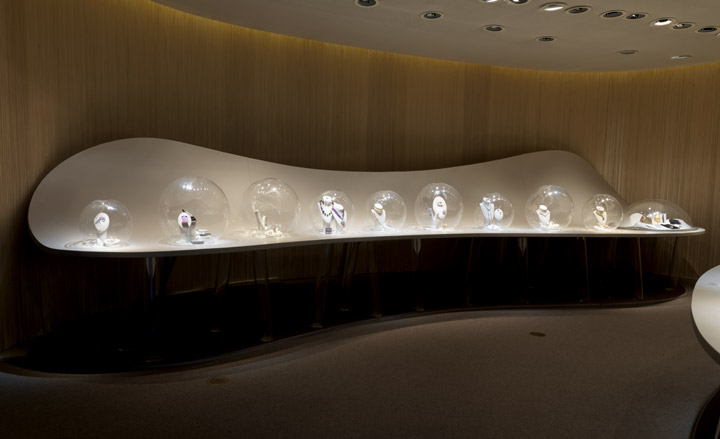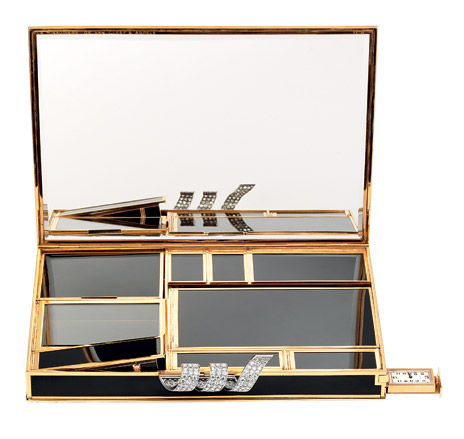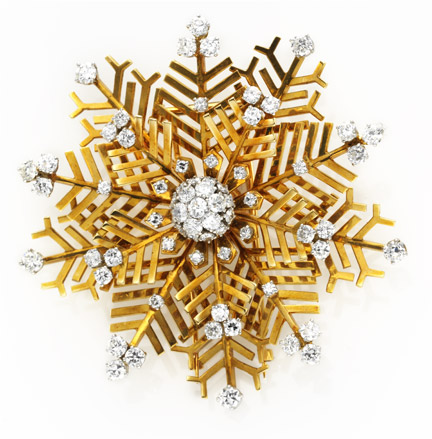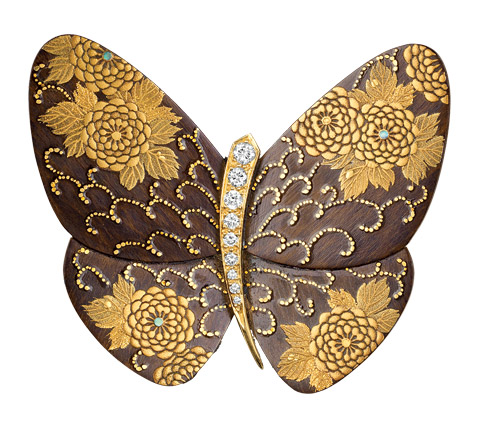Van Cleef & Arpels show by Jouin Manku Studio

Fantastical, interactive, and dare we say, almost touchable? There is something rather liberating about 'Set in Style', which bears the opposite traits to the customary jewellery exhibition, where things are kept at arms length, encased in deep glass cabinets, far from prying hands. No prizes for guessing then, that French designer Patrick Jouin had his conceptual hand in the installation for this heritage jewellery brand's New York showcase.
Holding court within the historical confines of the Smithsonian's Cooper-Hewitt National Design Museum, the exhibition is a veritable cross-section of the Van Cleef & Arpels brand. A tempting offering of the Maison's important creations are set within clever concepts such as 3-D holograms (the nifty contraptions allow for 360-degree viewing and amplification of jewellery details, ideal for visitors who want to take in every crevice and cut) and specially-commissioned minimally meditative music by American composer Nicolas Jaar.
Jouin and his partner Sanjit Manku of Jouin Manku studio have been sympathetic towards the space - an early 20th century former private mansion, rich with woodwork and carvings - bringing out the building's past through things like the opulently jewel-drenched dining table, and bringing in modern touches like the bubble-style glass dome containers.
The interactive element is an important one here. 'Strangely enough, although there are a lot of platforms where you can see art, architecture and design, jewellery isn’t always very accessible,' says Nicolas Bos, creative director of Van Cleef & Arpels. A lot is private collection based and jewellery over the last decade has suffered from not being shown anymore. There is so much more to it than just big stones and expensive pieces. It's important to show how the craftsmanship and designs have developed along the centuries'.
Wallpaper* caught up with Patrick Jouin to discover the vision behind the project:
What was the idea behind your conception for the space?
For it to be a platform for people to be able to appreciate and understand the work of Van Cleef & Arpels. Jewellery is so small, you can just pass by and not be aware of it. The idea of the architecture of the space is to create this special emotion for people to be surprised, to look and notice. Carnegie Mansion is one of the most beautiful houses in New York, and the aesthetic of the house is so strong. It’s like I’ve asked the house to do the design - almost like the house has whispered in my ear about what we’re supposed to do.
Wallpaper* Newsletter
Receive our daily digest of inspiration, escapism and design stories from around the world direct to your inbox.
There seems to be a big focus on multi-sensory-driven features, like the 3-D holograms and the specially-commissioned music for each room. What was it that you wished to convey through these elements?
I wanted to create an element of surprise. The hologram of the jewellery is a simple magical trick – you can almost touch it! Most visitors can’t buy the pieces, so on top of there being the ‘fun’ element, it was also important that there wasn’t any barrier between visitor and jewellery.
What were the biggest challenges you faced?
There are 300 pieces! With so many items, I had to set things out so visitors keep a good pace and rhythm when they move in the space.
What particular elements of Van Cleef & Arpels did you wish to draw out through your installation?
Fantasy. Van Cleef & Arpels is inspired by nature and the ethereal, so I wanted to play with scale. I didn’t want to put the jewellery in boxes and pieces of 20mm-thick plexiglas that you can’t break with a hammer. I decided to make bubble-like structures that encase the pieces, so you can almost go all the way round the jewellery and see it from all angles.
You’re known for your modern, functional and minimal approach to design. How did you marry a contemporary aesthetic with the historic spaces of the museum and the intricateness of Van Cleef & Arpels’ pieces?
In France we have so many old things so, as an interior architect and designer I am used to this tension between the historical and the modern. I am never afraid of the past and its beauty. So I think it’s even easier when you’re in a beautiful historical space – there’s always a strong connection and tension. Context is important in everything I do. In this case, the context is a grand old house, so I tried to speak to it.

Holding court within the historical confines of the Smithsonian's Cooper-Hewitt National Design Museum, the exhibition is a veritable cross-section of the Van Cleef & Arpels brand, showcased in a highly original exhibition concept.
© Smithsonian Institution

A selection of the Maison's important creations have been set within clever concepts such as 3-D holograms and specially-commissioned minimally meditative music by American composer Nicolas Jaar.
© Smithsonian Institution

Jouin has been sympathetic towards the space, essentially bringing out the building's past through things like the opulently jewel-drenched dining table...

... and bringing in modern touches like the bubble-style glass dome containers.

Installation view of 'Set in Style'
© Smithsonian Institution

Watercolor drawing: Passe-partout chain necklace/belt with floral clips
Paris, France, ca. 1947
Van Cleef & Arpels’ Archives
Courtesy of Van Cleef & Arpels

Egyptian bracelet
Designed by Van Cleef & Arpels
Paris, France, ca. 1924
Emeralds, rubies, sapphires, diamonds, platinum
Courtesy of Primavera Gallery, New York

Jarretière bracelet owned by Marlene Dietrich
Designed by Van Cleef & Arpels
Paris, France, ca. 1937
Diamonds, rubies, platinum
Courtesy of Private Collection, New York

Manchette (cuff) bracelet/necklace owned by Daisy Fellowes
Designed by Van Cleef & Arpels
Paris, France, 1926 (bracelet), 1928 (second bracelet to form necklace)
Platinum, emeralds, diamonds
California Collection

Padlock watch owned by Paulette Goddard
Designed by Van Cleef & Arpels
New York, NY, 1940
Diamonds, platinum
Van Cleef & Arpels Collection

Tiara worn by H.S.H. Princess Grace of Monaco
Designed by Van Cleef & Arpels
Paris, France, 1976
Gold, platinum, diamonds
Van Cleef & Arpels Collection

Peony brooch
Designed by Van Cleef & Arpels
Paris, France, 1937
Gold, platinum, diamonds, Mystery Set rubies
Van Cleef & Arpels Collection

Volutes Minaudière
Designed by Van Cleef & Arpels
Paris, France, 1935
Yellow gold, black lacquer, diamonds
Van Cleef & Arpels Collection

Orchid brooch
Designed by Van Cleef & Arpels
Paris, France, 1928
Platinum, diamonds
Van Cleef & Arpels Collection

Lace Bow Knot brooch
Designed by Van Cleef & Arpels
Paris, France, 1945
Yellow gold, platinum, diamonds
Van Cleef & Arpels Collection

Goddess Head brooch
Designed by Van Cleef & Arpels
New York, NY, 1970
Gold, turquoise, rubies, emeralds, sapphires, diamonds
Courtesy of Richters of Palm Beach

Necklace with pendant owned by Begum Aga Khan
Designed by Van Cleef & Arpels
Paris, France, 1971
Yellow gold, carved emeralds, diamonds
Van Cleef & Arpels Collection

Brooch/pendant of bird and briolette diamond owned by Ganna Walska
Designed by Van Cleef & Arpels
New York, NY, 1971
Yellow gold, sapphires, yellow diamonds (briolette 95 carats), white diamonds
Bird brooch and detachable briolette and wings
Courtesy of Private Collection

Snowflake brooch
Designed by Van Cleef & Arpels
Paris, France, 1948
Yellow gold, diamonds, platinum
Courtesy of Jean S. and Frederic A. Sharf

Camargo brooch
Designed by Van Cleef & Arpels
New York, NY, 1942
Platinum, diamonds, rubies, emeralds
Private Collection

Kikumakie brooch
Designed by Van Cleef & Arpels
Paris, France, and Japan, 2004
Yellow gold, wood, lacquer, diamonds
Van Cleef & Arpels Collection

Scylla necklace with detachable clip
Designed by Van Cleef & Arpels
Paris, France, 2008
Diamonds, white gold
Courtesy of Private Collection

Zip necklace/bracelet
Designed by Van Cleef & Arpels
Paris, France, 1952
Yellow gold, diamonds
California Collection

Lamartine bracelet owned by Elizabeth Taylor
Designed by Van Cleef & Arpels
France, 1970
Yellow gold, platinum, diamonds, coral, amethyst
Courtesy of Dame Elizabeth Taylor
ADDRESS
Cooper-Hewitt, National Design Museum
Smithsonian
2 East 91st Street
New York
NY 10028
-
 Enter the world of Cave Bureau, and its architectural and geological explorations
Enter the world of Cave Bureau, and its architectural and geological explorationsNairobi practice Cave Bureau explores architecture’s role in the geological afterlives of colonialism, as part of a team exhibiting at the British pavilion at the Venice Architecture Biennale 2025
By Marwa El Mubark
-
 All-In is the Paris-based label making full-force fashion for main character dressing
All-In is the Paris-based label making full-force fashion for main character dressingPart of our monthly Uprising series, Wallpaper* meets Benjamin Barron and Bror August Vestbø of All-In, the LVMH Prize-nominated label which bases its collections on a riotous cast of characters – real and imagined
By Orla Brennan
-
 Maserati joins forces with Giorgetti for a turbo-charged relationship
Maserati joins forces with Giorgetti for a turbo-charged relationshipAnnouncing their marriage during Milan Design Week, the brands unveiled a collection, a car and a long term commitment
By Hugo Macdonald